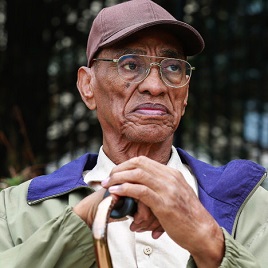 Photo by Courtney Manion for the New York Times On October 15, 1963, 43-year-old Lawrence Rothbort, a painter and sculptor, was fatally shot in his home in the Crown Heights neighborhood of Brooklyn, New York.
Rothbort’s wife, Marlene, who was nine months pregnant, said a black man with a shotgun demanded money and when Rothbort refused, the man shot him.
A month after the shooting, police arrested 29-year-old Paul Gatling based on a tip from a convicted felon named Grady Reaves who said he saw Gatling in the area of Rothbort’s home immediately after the shooting.
Gatling told police that he was there to pay his rent to his landlord—which the landlord confirmed for police.
Gatling, who was 6 feet 1 inch tall, was placed in a lineup with three much shorter men. However, Rothbort’s widow was unable to identify anyone as the gunman. Later, she viewed Gatling as he was being questioned by detectives and she then identified him as the gunman.
Facing the death penalty, Gatling went to trial in Kings County Supreme Court. In the middle of trial, he pled guilty and was sentenced to 30 years to life. He immediately attempted to withdraw his guilty plea, but that motion was denied. Ultimately, Malvina Nathanson, a Legal Aid Society lawyer, came to believe in Gatling’s innocence. In 1973, after years of working on the case, she sent a report and an application for clemency to then-Governor Nelson Rockefeller, who commuted Gatling’s sentence. Gatling was released on parole in January 1974.
Forty years later, in 2014, Gatling learned that Brooklyn District Attorney Ken Thompson had formed a Conviction Review Unit to re-investigate cases of convicted defendants who made credible claims of innocence. Gatling reached out to Nathanson and, on her advice, he sent a letter to Thompson.
The conviction review unit’s investigation uncovered evidence that had not been disclosed to Gatling’s defense attorney at the time of the trial. The evidence was that Rothbort’s wife, Marlene, admitted to detectives that she was having an affair with a musician who boarded in the Rothbort’s home. The musician, Leon Tolbert, told detectives he heard Marlene tell Rothbort that she would kill him if he continued to beat her.
“In 1964, an African-American accused of killing a Caucasian in front of his family with a blue-ribbon jury—this case was hopeless,” Mark Hale, the head of the Conviction Review Unit, said. Gatling’s conviction relied primarily on Marlene’s eyewitness testimony.
“Her dialogue was [out] of a bad b-movie ... Mrs. Rothbort may have been involved in the murder,” Hale said.
On May 2, 2016, Hale, Thompson, and Gatling appeared before Supreme Court Justice Dineen Riviezzo, who granted the prosecution’s motion to vacate the conviction and to dismiss the charges.
Gatling told Judge Riviezzo, “I can’t tell the court the pain and suffering. What has happened to me, this has stopped me from voting at every level. I come from a civic family and they don’t understand why poppa can’t vote.”
Gatling filed a claim for compensation with the state of New York and in 2018 settled the claim for $600,000. That same year, Gatling also settled a claim against the City of New York for $1.5 million.
– Maurice Possley
|